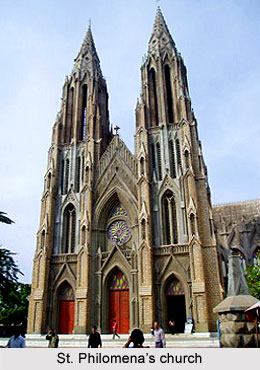 St. Philomena`s church was built in 1933 by the king of Mysore. It was built under the supervision of Bishop Rene Feuga. This church has a blending of local culture. Some of the female statues have been dressed sarees.
St. Philomena`s church was built in 1933 by the king of Mysore. It was built under the supervision of Bishop Rene Feuga. This church has a blending of local culture. Some of the female statues have been dressed sarees.
History of St. Philomena`s Church
St. Philomena`s church was constructed in 1936 using a Neo Gothic style and its architecture was inspired by the Cologne Cathedral in Germany. Saint Philomena is a saint as well as a martyr of the Roman Catholic Church. She was a young Greek princess who was martyred in the 4th century. The remains were discovered on May 24, 1802 in the Catacombs of Saint Priscilla at the Via Salaria in Rome. There were several fragmented inscriptions containing the words LUMENA PAXTE CUMFI. From these discoveries, it was concluded that a Christian named Philomena was buried in the tomb.
A church was built in 1843 by the then Maharaja Mummadi Krishnaraja Wodeyar. In 1926, Thamboo Chetty who was a secretary to the Maharaja of Mysore, Nalvadi Krishnaraja Wodeyar obtained a relic of the saint from Peter Pisani, Apostolic Delegate of the East Indies. The relic was handed over to Father Cochet who approached the king to assist him in constructing a church in honour of St. Philomena. The Maharaja of Mysore laid the foundation stone on October 28, 1933. The relic of Saint Philomena is preserved in a cavern below the main altar.
Architecture of St. Philomena`s Church
The church was designed by Daly, a French man. It was built in the Neo Gothic style with inspiration drawn from the Cologne Cathedral. The floor plan resembles a cross. The long part of the cross is congregation hall known as the nave. Transepts are the two arms of the cross. The crossing is the part containing the altar and the choir. The cathedral has a cellar that houses a statue of St. Philomena. The twin spires of the church resemble the spires of the Cologne Cathedral and St. Patrick`s Church in New York. The main hall contains stained glass windows depicting scenes from the birth of Christ, the Last Supper, the Crucifixion, the Resurrection and the Ascension of Christ.











